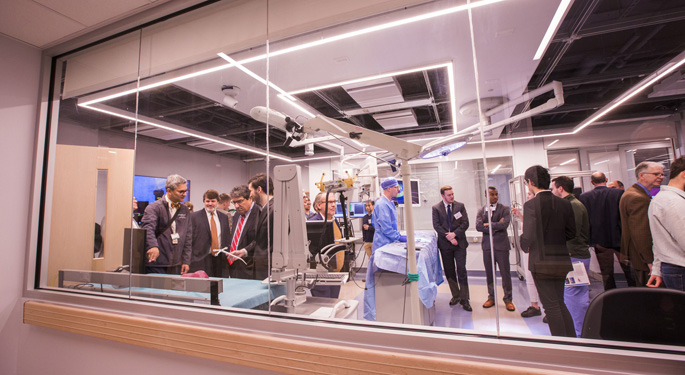
The Vanderbilt Institute for Surgery and Engineering (VISE) celebrated the opening of dedicated space in Medical Center North Dec. 12 with a technology showcase of more than two dozen collaborations advancing health care techniques from the lab to patient.
VISE is an interdisciplinary, trans-institutional program that supports interactions between engineers and physicians in order to develop methods, devices, algorithms and systems to improve patient care.
The newly designed 7,000-square-foot suite is near the Vanderbilt Institute for Imaging Sciences (VUIIS) and the recently renovated Clinical Research Center (CRC), as well as the clinical operating rooms at Vanderbilt University Adult Hospital. The space includes a mock operating room equipped with surgical robots, imaging devices, and tracking and surgical guidance systems. It also includes a shared development area, several smaller development labs, a machine shop equipped with a 3-D printer and a laser cutter, a wet laboratory, office space and a conference room.
“This is the manifestation of what a great university committed to scholarly research and outstanding teaching does to change the world,” Vanderbilt University Chancellor Nicholas S. Zeppos said. “The excitement and bold vision of our faculty and students engaged in research here is truly affirming of our university’s mission.”
“This space is the physical embodiment of the VISE concept,” said Benoit Dawant, director of VISE and Cornelius Vanderbilt Professor of Engineering. “It will be project-oriented and host interdisciplinary teams working on projects advancing VISE’s mission. It will facilitate new trans-institutional interactions and foster new projects and ideas.”
Dawant credited the collegiality of the Vanderbilt faculty over the past three decades for the formation of VISE.
“Before 2010, when the Vanderbilt Initiative in Surgery and Engineering was created, we had developed a network of collaborators who were successful, but the effort needed more organization,” he said. “As we developed a critical mass of expertise in the area of interventional processes, we developed more visibility on campus, and VISE moved up from an initiative to an actual institute in 2015.”
Among those Dawant thanked for providing resources were Zeppos and Jeff Balser, MD, PhD, President and Chief Executive Officer of Vanderbilt University Medical Center and Dean of Vanderbilt University School of Medicine; Gordon Bernard, MD, Senior Associate Dean for Clinical Sciences and Executive Vice President for Research; Susan Wente, PhD, Provost and Vice Chancellor for Academic Affairs; and Phillipe Fauchet, PhD, Bruce and Bridgitt Evans Dean’s Professor of Engineering.
Forty students have earned their doctorates since the program’s start as an initiative, and there are 55 current students engaged in research at VISE. In addition, 26 patents and seven licenses have come out of this collaborative work, and the effort is supported by more than $30 million in active grants. Currently, there are 10 core engineering faculty and more than 40 clinicians affiliated with VISE.
“We have an incredibly compact campus where engineering and medicine are adjacent to one another, and that’s a great advantage that can never go away,” Fauchet said.
Balser noted the proximity of the new VISE home to the offices of many of the surgical department faculty and lauded the architectural design and construction teams for their work.
“There could not be a better location,” he said.
“This is a really unique resource for us in the Department of Surgery and in the Section of Surgical Sciences,” said Seth Karp, MD, professor and chair of the Section of Surgical Sciences. “Surgeons are busy, and to be able to walk from the operating room to their office and pass this center, there’s just no price you can put on that.”
“The acronym for VISE emerged from how two jaws — representing surgery and engineering — of a mechanical vise function to hold a problem for ongoing work and study,” said urologic surgeon Duke Herrell, MD, chair of the Vanderbilt Robotics Committee and a member of the VISE steering committee. “This state-of-the art space creates a unique site to allow us to attract the best people, create world-class teams and collaborations, and continue the innovations that are making amazing changes to how surgery can help our patients.”
Technology demonstrations during the open house included robots for trans-nasal surgery and bladder tumor resection; a guidance system for cochlear implantation; a flexible endoscope guided by magnets; guidance systems for liver surgery and for the placement of electrodes in the brain; and new methods for imaging blood flow with ultrasound technology.












